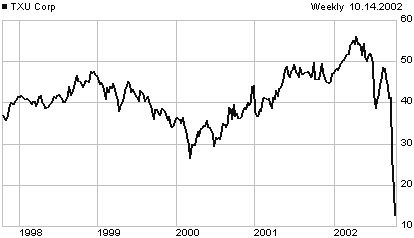 On
an October 14:
On
an October 14:
2002 After having suffered on the New York Stock Exchange
a precipitous drop from a $42.41 intraday high on 30 September to a $14.75
intraday low on 08 October, the stock of TXU Corporation is downgraded
(better late than never?) by Morgan Stanley from Equal-weight to Underweight
and by CSFB from Neutral to Underperform. Standard & Poor's lowers its
long-term corporate credit rating on TXU to BBB from BBB+. TXU cuts its
quarterly from 60 to 12.5 cents per share and announces that its European
operations are for sale. From its recovery close of $18.75 in the previous
session, TXU falls to an intraday low of $10.10 and closes at $12.94.
39 million of its 278 million shares are traded. TXU had traded as high
as $57.05 as recently as 24 April 2002. [5~year price chart >].
TXU is a holding company which through its subsidiaries engages in the
generation, purchase and distribution of electricity; the processing,
transmission and distribution of natural gas; and power development and
telecommunications.
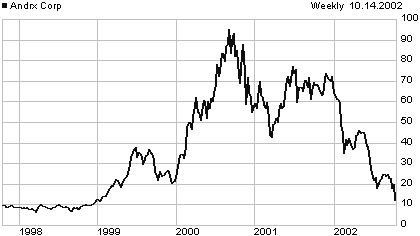
2002 (Monday) After a trial that lasted from 06 December
2001 to June 2002, late on Friday 11 October 2002 a US District Judge
unexpectedly found that generic drug manufacturers Andrx, Genpharm
(a Canadian affiliate of Merck KGaA, Darmstadt, Germany), and Cheminor
(a division of Dr
Reddy’s Laboratories Ltd., RDY, based in India) infringed on two patents
(230 and 505) for the manufacture of the heartburn medicine omeprazole,
held by AstraZeneca PLC which sells it under the name Prilosec (for a
total of $5.7 billion in 2001). Andrx Corporation (ADRX) is downgraded
by Wachovia Securities from Strong Buy to Buy, by CIBC World Markets from
Sector Outperform to Sector Underperform, and by CSFB from Neutral to
Underperform. On the AMEX, ADRX shares fall from their previous close
of $19.99 to an intraday low of $10.75 and close at $12.00. 19 million
of its 71 million shares are traded. It had traded as high as $76.52 on
06 December 2001 and $95.38 on 04 September 2000. [< 5~year
price chart]. — AstraZeneca Group (AZN) in upgraded by JP Morgan
from Underweight to Neutral, by Bear Stearns from Underperform to Peer
Perform, by Goldman Sachs from Market Perform to Market Outperform. AZN
shares, on the New York Stock Exchange, rise from their previous close
of $32.55 to an intraday hih of $37.98 and close at $36.60. — On
the New York Stock Exchange, the RDY American Depositary Receipts decline
from their previous close of $17.48 to an intraday low of $15.35 and close
at $15.45.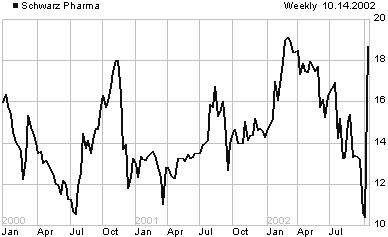 — The judge found that KUDco, a unit of Germany's Schwarz Pharma
(SRZ), didn't infringe on AstraZeneca's patents. WestLB stuft Schwarz
Pharma von Neutral auf Buy. Shares of Schwarz Pharma, on the German XETRA,
rise from their previous close of €10.40 to an intraday high of €19.35
and close at €18.70. not far from their 11 March 2002 high of €19.25.
[3~year price chart >]
— The judge found that KUDco, a unit of Germany's Schwarz Pharma
(SRZ), didn't infringe on AstraZeneca's patents. WestLB stuft Schwarz
Pharma von Neutral auf Buy. Shares of Schwarz Pharma, on the German XETRA,
rise from their previous close of €10.40 to an intraday high of €19.35
and close at €18.70. not far from their 11 March 2002 high of €19.25.
[3~year price chart >]
2002 Cardinal Giovanni Battista Re, prefect of the Vatican's
Congregation of Bishops
replies to Bishop Wilton D. Gregory, president of the United States
Conference of Catholic Bishops, concerning the US bishops' request for
recognitio of policy
for dealing with sexual abusers in the clergy.
2001 Midterm elections in Argentina for all 72 Senate
seats, half of the Chamber of Deputies' 257 seats, and places in most
of the 23 provincial legislatures.
2001 Jürgen
Habermas, 72, German philosopher and sociologist, is awarded the Peace
Prize of the German Booktraders' Association, in Frankfurt, Germany.—
Major Works of Habermas in English: Knowledge and Human Interests
— Toward a Rational Society — Theory and Practice — Communication
and the Evolution of Society — Legitimation Crisis — Justification
and Application: Remarks on Discourse Ethics — Philosophical-Political
Profiles — The Theory of Communicative Action, Volume One: Reason
and the Rationalization of Society — Autonomy and Solidarity —
The Theory of Communicative Action, Volume Two: The Critique of Functionalist
Reason — The Philosophical Discourse of Modernity — On the Logic
of the Social Sciences — The Structural Transformation of the Public
Sphere: An Inquiry into a Category of Bourgeois Society — Moral Consciousness
and Communicative Action — Postmetaphysical Thinking: Philosophical
Essays
2001 Delta Flight 458 from Atlanta to Newark, New Jersey,
is diverted to Charlotte-Douglas International Airport, and passengers
are taken off the flight while officials investigate a report of two "Middle
Eastern men" making threats in a foreign tongue. It turns out to be two
Orthodox Jews who were peacefully praying.
2000 Two hijackers seize a London-bound Saudi Arabian
Airlines jetliner carrying more than 100 people, taking it first to Syria
and then to Baghdad, Iraq, where the hijackers surrender peacefully.
| 1996 Viacom and Sprint to offer
online content Viacom and Sprint announce that they will jointly develop and distribute online media products. Although Viacom had announced a year earlier that it would provide content, including online programs relating to Star Trek and Entertainment Weekly, through the Microsoft Network's proprietary online system, the Web was quickly becoming a more desirable place for content providers to offer their information. Many content providers found they preferred creating in-house Web sites to providing content through online services because they had more control over the content and visual presentation of the material. |
1996 The Dow Jones industrial average closed above 6000 for the first time (at 6010).
1996 Chrysler Corporation announces that it had record net earnings of $680 million for the third quarter. Not only were 1996 sales of RAM pickup trucks way up, but company officials managed to keep the factory lines rolling by making a labor deal with the United Auto Workers. Chrysler's stock makes a $1.00 gain, to a close of $32.75.
| 1991 The
Nobel Peace Prize to Aung San Suu Kyi, Myanmar human rights activist. The Norwegian Nobel Committee has decided to award the Nobel Peace Prize for 1991 to Aung San Suu Kyi of Myanmar (Burma) for her non-violent struggle for democracy and human rights. — MORE |
| 1986 Concentration camp survivor
Elie
Wiesel, 58, wins
Nobel Peace Prize. The Norwegian Nobel Committee in Oslo has decided to award the Nobel Peace Prize for 2001 to Elie Wiesel, lecturer and author of some 30 books with a commitment, which originated in the sufferings of the Jewish people, and has been widened to embrace all repressed peoples and races. . — MORE |
| 1979 Homosexuals march on Washington
^top^ Over 100'000 homosexuals, lesbians, bisexuals, and supporters march on Washington, D.C., celebrating "gay pride" and demanding equal rights for homosexuals under the law. The first national homosexual rights march comes ten years after New York City's Stonewall Riot provided a symbolic beginning for the homosexual civil rights movement. In the early morning hours of June 28, 1969, a police raid of the Stonewall Inn--a gay club on New York City's Christopher Street--turned violent as patrons and local sympathizers began rioting against the police. Although the police were justified in raiding the club, which was serving liquor without a license among other violations, New York's homosexuals had grown weary of the police department's targeting of homosexual clubs, the majority of which had already been closed. The crowd on the street watched quietly as Stonewall's employees were arrested, but then three drag queens and a lesbian were forced into the paddy wagon, and the mob began throwing coins and then bottles at the police. The officers were forced to take shelter in the establishment, and two policemen were slightly injured before reinforcements arrived to disperse the crowd. However, the protest expanded into the neighboring downtown streets, and order was not returned until the deployment of New York's riot police. The Stonewall Riot was followed by several days of demonstrations in New York, and was the impetus for the formation of the Gay Liberation Front among other gay, lesbian, and bisexual civil rights organizations. |
1969 Race riots in Springfield, Massachusetts.
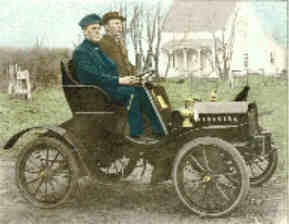 1899
"The horseless carriage will never come into common use.”
1899
"The horseless carriage will never come into common use.”
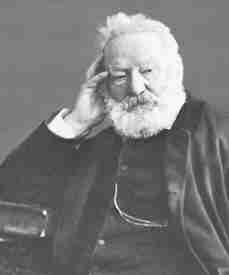 1822
1822
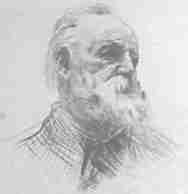 In 1823, Hugo published his first novel,
In 1823, Hugo published his first novel,  Deaths
Deaths 2002
Linda Gail Franklin, 47, by a single .223-caliber bullet from high-powered
rifle “X”, at 21:15, in the parking of a Home Depot at the Seven
Corners shopping center near Falls Church, Virginia, 10 km from Washington
DC. Police immediately close for three hours neighboring higways backing
up traffic more than 15 km, but do not find trace of the killer [photo:
Route 50, shopping center in background >]. Linda Franklin
[< photo] was with her computer network engineer husband
Ted, loading purchases into their car. She was a breast cancer survivor
undergoing physical therapy for a 2001 double mastectomy. Since shortly
after the FBI National Infrastructure Protection Center was created in 1998,
she was an intelligence operations specialist there. — Eight previous
rifle “X” killings and two woundings have occured since 02 October.
About 400 FBI agents, trainees and counter-terrorism agents have been assigned
to the case. Organized terrorism should be suspected, in my opinion, considering
how successful those killings are in causing media overcoverage and police
overreaction, thus disrupting the Washington area and resulting in enormous
economic loss.
2002
Linda Gail Franklin, 47, by a single .223-caliber bullet from high-powered
rifle “X”, at 21:15, in the parking of a Home Depot at the Seven
Corners shopping center near Falls Church, Virginia, 10 km from Washington
DC. Police immediately close for three hours neighboring higways backing
up traffic more than 15 km, but do not find trace of the killer [photo:
Route 50, shopping center in background >]. Linda Franklin
[< photo] was with her computer network engineer husband
Ted, loading purchases into their car. She was a breast cancer survivor
undergoing physical therapy for a 2001 double mastectomy. Since shortly
after the FBI National Infrastructure Protection Center was created in 1998,
she was an intelligence operations specialist there. — Eight previous
rifle “X” killings and two woundings have occured since 02 October.
About 400 FBI agents, trainees and counter-terrorism agents have been assigned
to the case. Organized terrorism should be suspected, in my opinion, considering
how successful those killings are in causing media overcoverage and police
overreaction, thus disrupting the Washington area and resulting in enormous
economic loss. 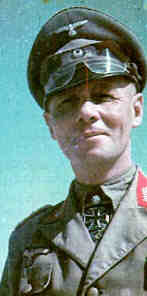 1944
Erwin Rommel, 52, forced suicide.
1944
Erwin Rommel, 52, forced suicide.
 1808
Simon Saint-Jean, French painter, specialized in still life and
flowers, who died on 03 July 1860. —
1808
Simon Saint-Jean, French painter, specialized in still life and
flowers, who died on 03 July 1860. —